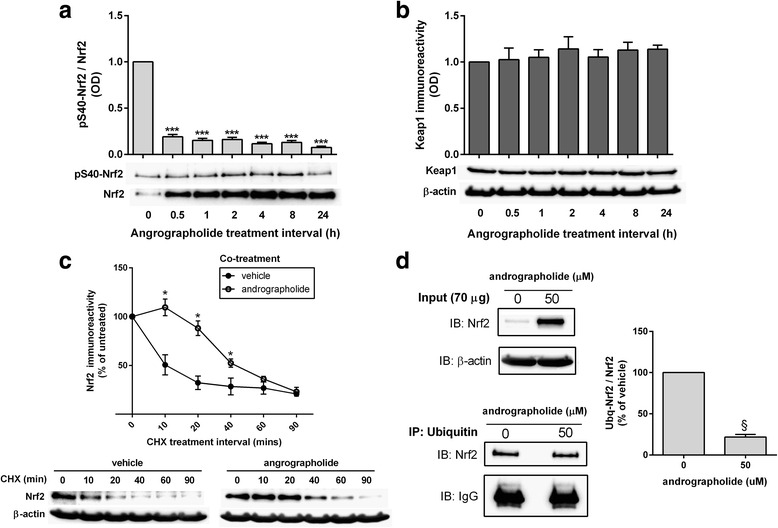Fig. 2.

Andrographolide increases stability of Nrf2 protein by altering ubiquitination efficiency. Primary astrocytes were treated with andrographolide (50 μM) for the indicated time intervals and measured for immunoreactivities of a pSer40 Nrf2/total Nrf2 as well as b Keap1 immunoreactivity normalized to β-actin (with representative immunoblots), and bar graphs showing mean ± S.E.M. fold changes in optical density (OD) with vehicle-only (“0 h”) group set as 1. ***p < 0.001; significantly different from vehicle-only group (one-way ANOVA with Dunnett’s post hoc tests). c Rat primary astrocytes were treated with cycloheximide (CHX, 10 μg/mL) with or without andrographolide (50 μM) co-incubation for the indicated time intervals and then measured for total Nrf2 immunoreactivity (with representative immunoblots). The graph represents mean ± S.E.M. Nrf2 immunoreactivities in vehicle-only (filled circles) and andrographolide co-treated (open circles) groups expressed as % of untreated (“0 h” CHX) group. *p < 0.05; significantly different from vehicle-only group (Student’s t tests). d Rat primary astrocytes were incubated with or without 50 μM of andrographolide for 1 h and processed for immunoprecipitation (see the “Methods” section), with representative input (IB) and ubiquitin-immunoprecipated (IP) blots for Nrf2. Bar graph shows mean ± S.E.M. immunoreactivity (fold changes in optical densities, OD with untreated group set at 100 %) of Ub-Nrf2/total Nrf2 normalized to β-actin. § p < 0.001 for comparison with untreated control (Student’s t tests). All data were from three to four independent experiments
